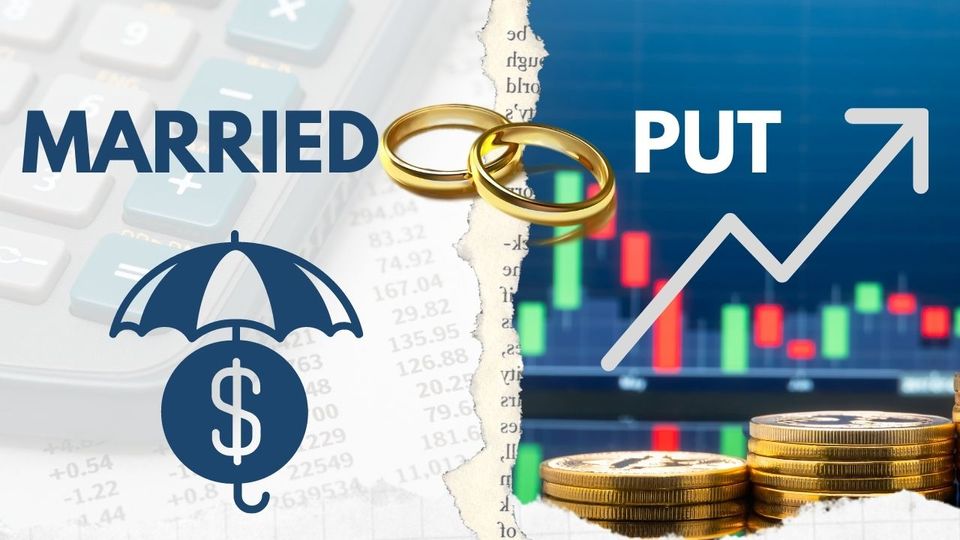Playbook #046: Options - Married Puts

🖼️ The Big Picture
The “Married Put” option strategy is a ninja trading technique used by all the big institutions for decades to minimize or completely remove the risk of loss, while maintaining unlimited upside potential.
It gives you additional ways to create income, and even save on taxes if you choose. Best of all, it can be almost completely passive once you make the trade. No need to constantly check prices. And you can sleep well at night knowing you’ve set your maximum loss in advance, guaranteed.
We like this strategy because Monte Carlo simulations prove that the biggest threat to most trading portfolios is large losses — and many options trading strategies expose you to 100% losses. Even a 50% loss takes a 100% gain on the rebound to get back to even!
With the married PUT strategy, you can engineer things so you never have more than 3-5% at risk — and that means your big winners actually build your wealth, not just offset your big losses.
Here’s an example of how this works:
Let’s say you buy 100 shares of InGen, trading at $20 per share for a total investment of $2,000.
The same day - it MUST be the same day, and you must have the broker mark that the put purchase was a hedge against long shares to let the IRS know that your intention is to hedge the stocks for more than a year - you buy 1 put contract with a:
- Strike price of $20 (giving you the right to sell your stock at $20 per share in case it drops below that)
- Expiration date of 4 months (meaning you must execute the contract and sell your shares within 4 months, or it expires)
- Contract price of $100 ($1 per share, and a contract is equal to 100 shares)
You’re into the trade for $2,100 total.
If the stock dives, the most you can lose is your put option premium of $100 (4.7%).
If the stock goes to the moon, you pocket every penny.
You may have heard of other strategies that supposedly protect your downside through “stop orders.” But the problem is, you’re not as protected as you think.
A “stop” order doesn’t mean that your stock will sell at the price you set (as many beginner retail investors believe). It means that it will sell at whatever the price is when the order is triggered.
So, using the example above, you could go to sleep one night feeling pretty good that your InGen stock - which you bought at $20 - has a “stop” order for $15 in case it crashes.
You wake up in the morning to see that the dinosaurs got out of the park and it dove 50% to $10 a share. You look at your account, and can’t believe it sold at $10 per share when your stop loss was $15! Well, the market opened at $10, so that’s what it was sold for. Sorry, your stock is dino soup.
In addition to being the single best way to trade with a guaranteed protected downside, you can also create more income by:
- Buying a dividend-paying stock for cash flow along the way.
- Buying a protective put with an expiration date of 12+ months so you can hold it for 1 year and a day and pay long term capital gains tax as opposed to short term capital gains tax.
- If the price of your stock rises, you can sell a call option against the shares you own, known as a “covered call.” This could cover, or come close to covering the cost of your protective put… meaning that you’ve eliminated any risk and are playing with house money!
In the example above, your $100 option premium is your maximum loss. If InGen rises from $20 to $25, you could sell a call option - giving the buyer the right to buy your shares for $22 if the price drops below that. Let’s say the option premium was $80. Now you’ve made back almost all of your $100 at risk, and you’re still in the trade with unlimited upside! Pretty cool right…
Note that the “married” part of this trade is critical. If you buy a protective put on your stock a few days, weeks, or months after buying it… it may not work as intended, and the tax advantages will be lost.
If you’re a long-term holder and looking for long-term capital gains, it’s important to know that buying a put option against stock erases your accrued holding period. The clock begins at zero.
So if, for example, you buy InGen on January 1st, but you’re nervous about it in November (because of an upcoming earnings call or the release of a new, controversial attraction)... so you buy a protective put. That buy resets the tax timeline and you would have to hold it for another year and a day to qualify for the long term capital gains rate.
🔢 By The Numbers
You don't have access to this CAPITALIZE issue at the moment, but if you upgrade your account you'll be able to see the whole thing, as well as all the other posts in the archive! Subscribing will give you immediate access.
This CAPITALIZE issue is for members only
Join nowWhat is CAPITALIZE?
CAPITALIZE is a tool for discovering new ways to grow your wealth. You get a new investment idea each week in a simple 7-Minute report. Quickly check to see if it matches your "Investor DNA" and fast-track your way to being a top 1% investor... with less risk. Created by Wealth Factory for people who want to build their wealth and keep it.
